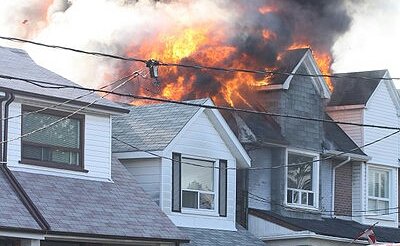Fire and Explosion in the Theatre, A Catastrophy
Although rare, fire and explosion in the theatre when it occurs are devastating to the patients, the operating theatre team and the hospital. Vigilance and knowledge of how it occurs and how to deal with it is paramount in militating against these problems. Fire is a rapid oxidation of material releasing heat, light and several chemical products. It occurs when a substance (Fuel) reacts with an oxidizing with release of energy. An explosion is a rapid physical chemical reaction accompanied by a large change in pressure (up to 2500kpa), producing a large amount of heat (temperature up to 300 degree centigrade), light and noise. This largely depends on an atmosphere of a mixture of flammable material with oxygen.
Classisfication of Fire

Donland's Fire outbreak BY Danielle Scott - CC BY 3.0, link
Class A – fire involving flammable solids e.g. wood, cloth
Class B – fire involving flammable liquid
Class C – fire involving flammable gases
Class D – Fire involving combustible metals
Class E – Fire involving energized electrical equipment
Class F – fire involving cooking fats & Oils
Elements aiding Fire and Explosion
For a fire or explosion to occur and be maintained, the three elements required to form the limbs of the fire triangle must be complete. These are:
1. Oxygen
2. Fuel
3. Heat or ignition source
In the operating theater environment, different team members have control over the three limbs of the fire triangle; Oxygen is controlled by anesthetists, potential fuel sources by nursing staff and ignition source by surgeons. Tackling fires therefore requires careful communication and team work.
1. Oxygen:
Oxygen enriched atmosphere is delivered to the patient for most surgical procedures. Oxygen supports reduce the energy and heat required to ignite fuel. Fuel that does not burn in air may do so in oxygen enriched environment of e.g. tracheal tubes will burn in 26% oxygen.
Strategies to reduce the risk posed by high oxygen concentration
●Limiting the storage of oxygen cylinder in the theatre
●Using the lowest concentration of oxygen that provides acceptable hemoglobin oxygen saturation
●Avoidance of open floe oxygen such as nasal cannula & Hudson masks
●Use of scavenging system
●Using antibacterial adhesive drapes
.jpg)
Bottles of chemicals BY Diane A. Reid - CC BY 3.0, link
2. Fuel:
There is a large number of potential fuel for combustion in the theatre environment. These include: Alcohol based skin preparations, surgical drapes in oxygen – rich environment. PCV tracheal tubes, methane intestinal gas, dry swabs, gauze and aerosol dressing, body hair with hair spray of gel.
Steps that can be taken to reduce the use of fuel ignition include:
●Avoiding the pooling and wicking of flammable skin preparation
●Ensuring skin prep has dried before applying drapes
●Considering aqueous based skin preparation
3. Heat and ignition sources:
Surgical diathermy is the heat source most likely to cause ignition. High temperatures are reached at the probe tip, which can persist for several seconds after the probe has been deactivated. Cutting mode is likely to ignite fuel than the coagulation mode and fires more likely with monopolar diathermy than bipolar.
Risk may be reduced by:
● Activating the diathermy only when the probe is under direct observation
● Placing the probe in a holster when not in use
● Using bipolar diathermy when open oxygen sources are use
Other ignition sources include: Lasers, Defibrillators, Static electricity, Adiabatic change, Electro-cautery, Malfunction electrical Equipment, drills, saws and fiber optic light source
Management of Surgical Fire
The ultimate goal is to prevent the occurrence of surgical fire by putting in place definite control measures of the elements involved in the initiation of fire. These will involve the various groups that control the limbs of the fire triangle, as outlined above. The management of a surgical fire includes prevention of small fire becoming out of control and causing damage to the patient, limiting and prompt control of large fire:
1. Small fires:
● Put out the fire with gloved hand or towel
● Fluid the area with sterile water or saline
2. Large Fire:
● Remove burning materials from patients and extinguish the fire
● Stop flow of oxygen to patient, & ventilate with room air
● If evacuation become necessary, use the acronym “RACE” which means Rescue patient, Alert other staff, Confine smoke and fire (close doors, shut gas and vacuum)
● Evacuate to a predetermined area.
_extinguish_a_fire_during_continual_firefighting_training.jpg)
Extingushing fire in progress BY David Mercil - CC BY 3.0, link
Airway fire
● Disconnect the breathing circuit
● Flood the oropharynx with sterile water or saline
● Consider flushing saline down tracheal tube to extinguish intraluminal fire
● Consider changing the tracheal tube. (potential source of further thermal injury)
● Perform bronchoscopy
● Consider steroid and antibiotic
● Transfer to ICU
Fire Extinguishers:
● Should be available in all theatres
● The choice of extinguisher depends on the type of fire
● Carbon dioxide extinguishers are used for class B and C
● Water based extinguisher for Class A
● Dry powder extinguishers for a, B, C, D and E
Fire blankets
Fire blankets should not be used on anaesthetized patients as they may cause severe injury.
Conclusion
It is imperative for the hospital management and indeed members of staff that use the theatre to put all necessary precautions in place in the theatre to avoid these devastating but avoidable problems, and to promptly manage it in the event of occurrence to limit the damage. Seminars on fires and explosion in the theatre and indeed the entire hospital should be organized as a form of training. Fire drill should be organized to aid preparedness to manage fire.
Please consult your Medical Physician for guidance on all health related issues
All Images Used In This Article, Are Linked To The Respective Owners
Thank you for reading
|References|
Fire_and_explosion_hazard_during_oxygen_use_in_operating_rooms
Environmental emergencies in theatre and critical care areas: power failure, fire, and explosion
Prevention of Fire and explosiions
ROBINSON J.S, JOHN M. THOMPSON, A.W. WOOD (2009) FIRE AND EXPLOSION HAZARDS IN OPERATING THEATRES: A REPLY AND NEW EVIDENCE British Journal of Anaesthesia. Volume 51, Issue 9, Pages 908
If you write STEM (Science, Technology, Engineering, and Mathematics) related posts, consider joining #steemSTEM on discord here. If you are from Nigeria, you may want to include the #stemng tag in your post. You can visit this blog by @stemng for more details. You can also check this blog post by @steemstem here and this guidelines here for help on how to be a member of @steemstem. Please also check this blog post from @steemstem on proper use of images devoid of copyright issues here

One of the greatest accidental occurrence in a theatre is an explosion or fire outbreak
Thank you for discussing this issue
Kudos on your effort
Resteemed
Congratulations! This post has been upvoted from the communal account, @minnowsupport, by oluwambe from the Minnow Support Project. It's a witness project run by aggroed, ausbitbank, teamsteem, theprophet0, someguy123, neoxian, followbtcnews, and netuoso. The goal is to help Steemit grow by supporting Minnows. Please find us at the Peace, Abundance, and Liberty Network (PALnet) Discord Channel. It's a completely public and open space to all members of the Steemit community who voluntarily choose to be there.
If you would like to delegate to the Minnow Support Project you can do so by clicking on the following links: 50SP, 100SP, 250SP, 500SP, 1000SP, 5000SP.
Be sure to leave at least 50SP undelegated on your account.
Quite an interesting read. Seems you've got a hang on the copyright rule of imaging. You may need help with formatting and arranging your work though. I'm on steemSTEM discord if you need help with that.
Ohhh, yeahh... Ii will defintely need help for improvement
Will contact you soon
Thanks
Congratulations @tbexpert! You have completed some achievement on Steemit and have been rewarded with new badge(s) :
Click on the badge to view your Board of Honor.
If you no longer want to receive notifications, reply to this comment with the word
STOPTo support your work, I also upvoted your post!
Do not miss the last post from @steemitboard!
Participate in the SteemitBoard World Cup Contest!
Collect World Cup badges and win free SBD
Support the Gold Sponsors of the contest: @good-karma and @lukestokes
Congratulations @tbexpert! You have completed some achievement on Steemit and have been rewarded with new badge(s) :
Click on the badge to view your Board of Honor.
If you no longer want to receive notifications, reply to this comment with the word
STOPDo not miss the last post from @steemitboard!
Participate in the SteemitBoard World Cup Contest!
Collect World Cup badges and win free SBD
Support the Gold Sponsors of the contest: @good-karma and @lukestokes